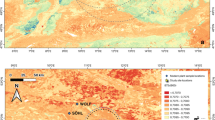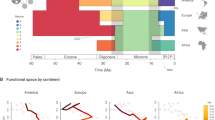Abstract
Eastern Africa is home to the largest terrestrial migrations on Earth. Though these migratory systems have been well studied for decades, little is known of their antiquity and evolutionary history. Serially sampled strontium stable isotopes (87Sr/86Sr) from tooth enamel can be used to track migration in mammals. Here we analyse 87Sr/86Sr for 79 bovid and equid individuals representing 18 species from four localities in Kenya to characterize prehistoric migratory systems during the Last Glacial Period (115–11.7 ka). Of the species analysed, 16 lack definitive evidence for migration, including blue wildebeest (Connochaetes taurinus), Thomson’s gazelle (Eudorcas thomsonii) and plains zebra (Equus quagga), which are long-distance migrants today in the Greater Serengeti Ecosystem and historically in the Athi-Kapiti Plains. Only two species, the extinct wildebeests Rusingoryx atopocranion and Megalotragus sp., were migratory. These findings suggest a possible alternative narrative about ecosystem dynamics during the Last Glacial Period and shed light on the behaviour of both extant and extinct species at this time. In particular, these results indicate that migratory behaviour in extant species either emerged during the Holocene or was more spatiotemporally constrained in the past. Our results contribute to a growing body of evidence suggesting that the structure and function of geologically recent large mammal communities in eastern Africa differed considerably from those observed in the present day.
This is a preview of subscription content, access via your institution
Access options
Access Nature and 54 other Nature Portfolio journals
Get Nature+, our best-value online-access subscription
$32.99 / 30 days
cancel any time
Subscribe to this journal
Receive 12 digital issues and online access to articles
$119.00 per year
only $9.92 per issue
Buy this article
- Purchase on SpringerLink
- Instant access to full article PDF
Prices may be subject to local taxes which are calculated during checkout



Similar content being viewed by others
Data availability
All raw data associated with this work are available in supplementary tables.
References
Estes, R. D. The Gnu’s World (Univ. California Press, 2014).
Allsopp, R. & Baldry, D. A. T. A general description of the Lambwe Valley area of South Nyanza District, Kenya. Bull. World Health Organ. 47, 691–697 (1972).
Marean, C. W. Hunter-gatherer foraging strategies in tropical grasslands: model building and testing in the East African Middle and Later Stone Age. J. Anthropol. Archaeol. 16, 189–225 (1997).
Holdo, R. M., Holt, R. D. & Fryxell, J. M. Opposing rainfall and plant nutritional gradients best explain the wildebeest migration in the Serengeti. Am. Nat. 173, 431–445 (2009).
Anderson, T. et al. Landscape-scale analyses suggest both nutrient and antipredator advantages to Serengeti herbivore hotspots. Ecology 91, 1519–1529 (2010).
Naidoo, R. et al. A newly discovered wildlife migration in Namibia and Botswana is the longest in Africa. Oryx 50, 138–146 (2016).
Morjan, M. D. et al. Armed conflict and development in South Sudan threatens some of Africa’s longest and largest ungulate migrations. Biodivers. Conserv. 27, 365–380 (2018).
Harris, G., Thirgood, S., Hopcraft, J. G. C., Cromsigt, J. P. & Berger, J. Global decline in aggregated migrations of large terrestrial mammals. Endanger. Species Res. 7, 55–76 (2009).
Hoppe, K., Koch, P., Carlson, R. & Webb, S. Tracking mammoths and mastodons: reconstruction of migratory behavior using strontium isotope ratios. Geology 27, 439–442 (1999).
Wooller, M. et al. Lifetime mobility of an Arctic woolly mammoth. Science 373, 806–808 (2021).
Britton, K., Grimes, V., Dau, J. & Richards, M. Reconstructing faunal migrations using intra-tooth sampling and strontium and oxygen isotope analyses: a case study of modern caribou (Rangifer tarandus granti). J. Archaeol. Sci. 36, 1163–1172 (2009).
Glassburn, C. et al. Strontium and oxygen isotope profiles of sequentially sampled modern bison (Bison bison bison) teeth from interior Alaska as proxies of seasonal mobility. Arctic 71, 183–200 (2018).
Hodell, D., Quinn, R., Brenner, M. & Kamenov, G. Spatial variation of strontium isotopes (Sr-87/Sr-86) in the Maya region: a tool for tracking ancient human migration. J. Archaeol. Sci. 31, 585–601 (2004).
Lugli, F. et al. Strontium and stable isotope evidence of human mobility strategies across the Last Glacial Maximum in southern Italy. Nat. Ecol. Evol. 3, 905–911 (2019).
Price, T. D., Knipper, C., Grupe, G. & Smrcka, V. Strontium isotopes and prehistoric human migration: the Bell Beaker period in central Europe. Eur. J. Archaeol. 7, 9–40 (2004).
Copeland, S. R. et al. Strontium isotope investigation of ungulate movement patterns on the Pleistocene Paleo-Agulhas Plain of the Greater Cape Floristic Region, South Africa. Quat. Sci. Rev. 141, 65–84 (2016).
Tucker, L. et al. Initial assessment of bioavailable strontium at Oldupai Gorge, Tanzania: potential for early mobility studies. J. Archaeol. Sci. https://doi.org/10.1016/j.jas.2019.105066 (2020).
Janzen, A. et al. Spatial variation in bioavailable strontium isotope ratios (Sr-87/Sr-86) in Kenya and northern Tanzania: Implications for ecology, paleoanthropology, and archaeology. Palaeogeogr. Palaeoclimatol. Palaeoecol. https://doi.org/10.1016/j.palaeo.2020.109957 (2020).
O’Brien, K. et al. Migratory behavior in the enigmatic Late Pleistocene bovid Rusingoryx atopocranion. Front. Environ. Archaeol. 2, 1237714 (2023).
Jenkins, K. E. et al. Evaluating the potential for tactical hunting in the Middle Stone Age: insights from a bonebed of the extinct bovid, Rusingoryx atopocranion. J. Hum. Evol. 108, 72–91 (2018).
Bataille, C. et al. A bioavailable strontium isoscape for Western Europe: a machine learning approach. PLoS ONE https://doi.org/10.1371/journal.pone.0197386 (2018).
Bataille, C., Crowley, B., Wooller, M. & Bowen, G. Advances in global bioavailable strontium isoscapes. Palaeogeogr. Palaeoclimatol. Palaeoecol. https://doi.org/10.1016/j.palaeo.2020.109849 (2020).
Lazzerini, N. et al. Monthly mobility inferred from isoscapes and laser ablation strontium isotope ratios in caprine tooth enamel. Sci. Rep. 11, 2277 (2021).
Yang, D. et al. BITS: a Bayesian isotope turnover and sampling model for strontium isotopes in proboscideans and its potential utility in movement ecology. Methods Ecol. Evol. 14, 2800–2813 (2023).
Estes, R. D. The Behavior Guide to African Mammals (Univ. California Press, 1991).
Tryon, C. A. et al. Late Pleistocene artefacts and fauna from Rusinga and Mfangano islands, Lake Victoria, Kenya. Azania Archaeol. Res. Afr. 47, 14–38 (2012).
Faith, J. T. et al. Paleoenvironmental context of the Middle Stone Age record from Karungu, Lake Victoria Basin, Kenya, and its implications for human and faunal dispersals in East Africa. J. Hum. Evol. 83, 28–45 (2015).
Staver, A. C. & Hempson, G. P. Seasonal dietary changes increase the abundances of savanna herbivore species. Sci. Adv. 6, eabd2848 (2020).
Marean, C. W. Late Quaternary Paleoenvironments and Faunal Exploitation in East Africa. PhD thesis, Univ. California, Berkeley (1990).
Silberbauer, G. B. Hunter and Habitat in the Central Kalahari Desert (Cambridge Univ. Press, 1981).
Lee, R. B. Kung spatial organization: an ecological and historical perspective. Hum. Ecol. 1, 125–147 (1972).
Bower, J. R. F., Nelson, C. M., Waibel, A. F. & Wandibba, S. The University of Massachusetts’ Later Stone Age/Pastoral ‘Neolithic’ comparative study in central Kenya: an overview. Azania. Archaeol. Res. Afr. 12, 119–146 (1977).
Bower, J. R. F. & Nelson, C. M. Early pottery and pastoral cultures of the Central Rift Valley, Kenya. Man 13, 554–566 (1978).
Coppolillo, P. B. et al. The landscape ecology of pastoral herding: spatial analysis of land use and livestock production in East Africa. Hum. Ecol. 28, 527–560 (2000).
Beverly, E. J. et al. Rapid Pleistocene desiccation and the future of Africa’s Lake Victoria. Earth Planet. Sci. Lett. 530, 115883 (2020).
Tryon, C. A. & Faith, J. T. A demographic perspective on the Middle to Later Stone Age transition from Nasera rockshelter, Tanzania. Philos. Trans. R. Soc. B 371, 20150238 (2016).
Faith, J. T., Rowan, J. & Du, A. Early hominins evolved within non-analog ecosystems. Proc. Natl Acad. Sci. USA 116, 21478–21483 (2019).
Tryon, C. A. et al. The Pleistocene prehistory of the Lake Victoria Basin. Quat. Int. 404, 100–114 (2016).
Faith, J. T. et al. Late Pleistocene mammals from Kibogo, Kenya: systematic paleontology, paleoenvironments, and non-analog associations. J. Vertebr. Paleontol. 40, e1841781 (2020).
Marean, C. W. Implications of late Quaternary mammalian fauna from Lukenya Hill (south-central Kenya) for paleoenvironmental change and faunal extinctions. Quat. Res. 37, 239–255 (1992).
Gramly, R. M. Upper Pleistocene archaeological occurrences at site GvJm/22, Lukenya Hill, Kenya. Man 11, 319–344 (1976).
Tryon, C. A. et al. Late Pleistocene age and archaeological context for the hominin calvaria from GvJm-22 (Lukenya Hill, Kenya). Proc. Natl Acad. Sci. USA 112, 2682–2687 (2015).
Sharp, W. et al. Th-230/U burial dating of ostrich eggshell. Quat. Sci. Rev. 219, 263–276 (2019).
Balasse, M., Bocherens, H., Mariotti, A. & Ambrose, S. Detection of dietary changes by intra-tooth carbon and nitrogen isotopic analysis: an experimental study of dentine collagen of cattle (Bos taurus). J. Archaeol. Sci. 28, 235–245 (2001).
Bendrey, R., Vella, D., Zazzo, A., Balasse, M. & Lepetz, S. Exponentially decreasing tooth growth rate in horse teeth: implications for isotopic analyses. Archaeometry 57, 1104–1124 (2015).
Milhaud, G. & Nezit, J. Molar development in sheep—morphology, radiography, microhardness. Recl. Med. Vet. 167, 121–127 (1991).
Nacarino-Meneses, C., Jordana, X., Orlandi-Oliveras, G. & Kohler, M. Reconstructing molar growth from enamel histology in extant and extinct Equus Sci. Rep. https://doi.org/10.1038/s41598-017-16227-2 (2017).
Zazzo, A. et al. The isotope record of short- and long-term dietary changes in sheep tooth enamel: implications for quantitative reconstruction of paleodiets. Geochim. Cosmochim. Acta 74, 3571–3586 (2010).
Hoppe, K., Stover, S., Pascoe, J. & Amundson, R. Tooth enamel biomineralization in extant horses: implications for isotopic microsampling. Palaeogeogr. Palaeoclimatol. Palaeoecol. 206, 355–365 (2004).
Mackey, G. N. & Fernandez, D. P. High throughput Sr isotope analysis using an automated column chemistry system. America Geophysical Union (2011).
Acknowledgements
Stable isotope processing was funded by the National Science Foundation Doctoral Dissertation Research Improvement Grant no. 2234426 to J.T.F. and K.O. and Graduate Research Fellowship (fellow ID 2020294514) to K.O., a Graduate Research Grant from the Leakey Foundation to K.O., the Dawson Grant from the Society of Vertebrate Paleontology to K.O. and a University of Utah Global Change and Sustainability Center Graduate Research Grant to K.O. We thank J. Rowan and A. Janzen for their roles in conceiving this project and S. Muteti and E. Ndiema for allowing destructive analysis on specimens at the National Museums of Kenya.
Author information
Authors and Affiliations
Contributions
K.O. and J.T.F. conceived the project. K.O., J.T.F., C.A.T. and T.E.C. provided funding. K.O., L.A., T.E.C., K.P. and D.P.F. conducted stable isotope analyses. K.O. wrote the paper. All authors provided paper feedback and gave final approval for paper publication.
Corresponding author
Ethics declarations
Competing interests
The authors declare no competing interests.
Peer review
Peer review information
Nature Ecology & Evolution thanks Abraham Dabengwa, Daniel Green and the other, anonymous, reviewer(s) for their contribution to the peer review of this work. Peer reviewer reports are available.
Additional information
Publisher’s note Springer Nature remains neutral with regard to jurisdictional claims in published maps and institutional affiliations.
Supplementary information
Supplementary Information
Supplementary text and Figs. 1–83.
Supplementary Tables 1 and 2
Supplementary Table 1. Results of 87Sr/86Sr and elemental ratios for all samples. Supplementary Table 2. Subsampled standard deviation values for all individuals and classification as migrant, possible migrant or non-migrant.
Rights and permissions
Springer Nature or its licensor (e.g. a society or other partner) holds exclusive rights to this article under a publishing agreement with the author(s) or other rightsholder(s); author self-archiving of the accepted manuscript version of this article is solely governed by the terms of such publishing agreement and applicable law.
About this article
Cite this article
O’Brien, K., Podkovyroff, K., Fernandez, D.P. et al. Limited herbivore migration during the Last Glacial Period of Kenya. Nat Ecol Evol 8, 1191–1198 (2024). https://doi.org/10.1038/s41559-024-02413-9
Received:
Accepted:
Published:
Issue date:
DOI: https://doi.org/10.1038/s41559-024-02413-9
This article is cited by
-
Looking back on 2024
Nature Ecology & Evolution (2025)
-
Strontium isotope mapping of elephant enamel supports an integrated microsampling-modeling workflow to reconstruct herbivore migrations
Communications Biology (2025)
-
Hunting, Fishing, and Herding in Later Stone Age and Iron Age Zambia: A Review of Zooarchaeological Evidence
African Archaeological Review (2025)
-
Strontium isoscape of sub-Saharan Africa allows tracing origins of victims of the transatlantic slave trade
Nature Communications (2024)



